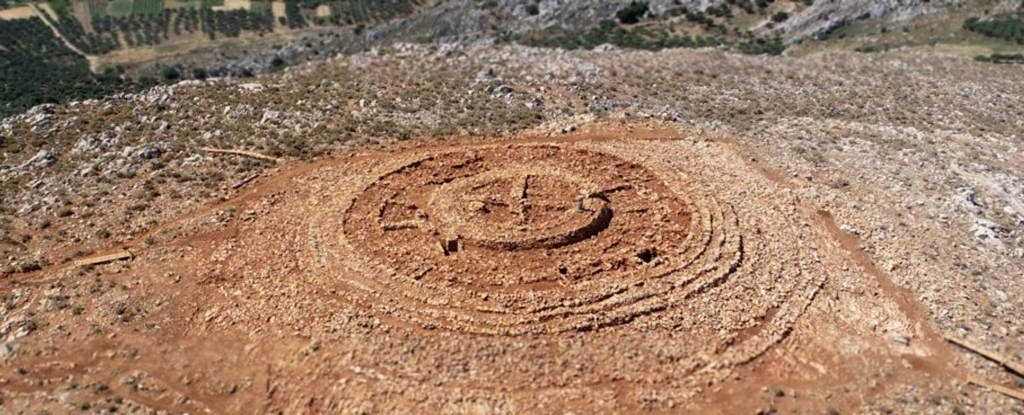A remarkable 4,000-year-old ring-shaped stone monument has been discovered on a hill in the Greek island of Crete.
The 1,800-square-meter (19,375-square-foot) Bronze Age structure was found at the top of Papoura Hill, northwest of the town of Kastelli, and was unearthed during excavation works for a major airport project.
The site is now being investigated by archaeologists who think it may have had a ritualistic or religious purpose.
The labyrinthine structure consists of eight concentric rings of stone, 1.4 meters (4.6 feet) thick on average, with some still standing at heights of up to 1.7 meters.
The architects of the newfound structure were from the Minoan culture of Crete, which is known for its peak sanctuaries, hill- and mountain-top sites believed to have been used in ancient rituals.
These sites often contain exquisite examples of Minoan art, including religious architecture, terracotta figurines of animals and humans, and in some cases detached body parts – referred to as “votive limbs” that were offered in prayer or as thanks for healing.
But it’s unclear whether the circular structure on Papoura Hill would qualify as a peak sanctuary – aside from its hilltop location, it’s unlike any other Minoan structure found to date.
In an announcement, the Greek Culture Ministry suggests “it may have been periodically used for possibly ritual ceremonies involving consumption of food, wine, and perhaps offerings,” due to the large quantity of animal bones found within.
The structure’s main period of use, 2000–1700 BCE, falls within the Middle Minoan period. During this time, populations on the island increased dramatically, particularly in Knossos, Phaistos, and Malia. With this boom began the construction of Crete’s iconic Minoan palaces, to meet the growing society’s needs.
The palaces were built in places that had been used for communal ceremonies for thousands of years. In around 1750–1700 BCE, many structures were destroyed; the leading theory is earthquakes.
After 1450 BCE, the island became dominated by Mycenaeans from the Greek mainland, and many of the peak sanctuaries that were widespread in Minoan culture fell out of use.
Remnants of pottery from the Neopalatial period (around 1750–1470 BCE) lead archeologists to think the site may have continued to be used well into the Middle Minoan.
It’s a difficult task planning construction in Greece, where plans are often thwarted by the discovery of yet another ancient historical site. The Kastelli airport project alone has already resulted in the discovery of at least 35 newly surfaced archeological sites, according to the Greek Culture Ministry.
The ministry was keen to reassure the public that the structure will be kept safe from modern construction, at least for now.
“This is a unique find of great interest. There are solutions, so that the archaeological research of the monument is completed and it is completely protected,” says archaeologist Lina Mendoni, the Greek Minister of Culture.
“The priority of all of us is the protection of the monument… We all understand the importance and value of cultural heritage.”











/https://tf-cmsv2-smithsonianmag-media.s3.amazonaws.com/filer_public/34/31/3431771d-41e2-4f97-aed2-c5f1df5295da/gettyimages-1441066266_web.jpg)







Discussion about this post